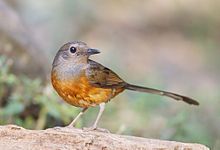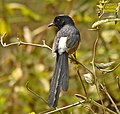
The common blackbird is a species of true thrush. It is also called the Eurasian blackbird, or simply the blackbird where this does not lead to confusion with a similar-looking local species. It breeds in Europe, Asiatic Russia, and North Africa, and has been introduced to Australia and New Zealand. It has a number of subspecies across its large range; a few of the Asian subspecies are sometimes considered to be full species. Depending on latitude, the common blackbird may be resident, partially migratory, or fully migratory.

The orange-headed thrush is a bird in the thrush family.

The fieldfare is a member of the thrush family Turdidae. It breeds in woodland and scrub in northern Europe and across the Palearctic. It is strongly migratory, with many northern birds moving south during the winter. It is a very rare breeder in Great Britain and Ireland, but winters in large numbers in the United Kingdom, Southern Europe, North Africa and the Middle East. It is omnivorous, eating a wide range of molluscs, insects and earthworms in the summer, and berries, grain and seeds in the winter.

The magpie-robins or shamas are medium-sized insectivorous birds in the genus Copsychus. They were formerly in the thrush family Turdidae, but are now treated as part of the Old World flycatcher family Muscicapidae. They are garden- and forest-dwelling species found in Africa and Asia.

The pied thrush is a member of the thrush family found in India and Sri Lanka. The males are conspicuously patterned in black and white while the females are olive brown and speckled. They breed in the central Himalayan forests and winter in the hill forests of southern India and Sri Lanka. Like many other thrushes, they forage on leaf litter below forest undergrowth and fly into trees when disturbed and sit still making them difficult to locate.
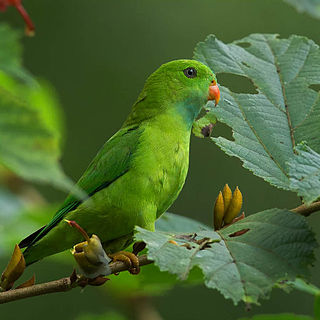
The vernal hanging parrot is a small parrot which is a resident breeder in the Indian subcontinent and some other areas of Southeast Asia. It undergoes local movements, driven mainly by the availability of the fruit, seeds, buds and blossoms that make up its diet. They frequent the banyan tree for the fruit and plantain trees for the nectar from the flowers.

The Indian robin is a species of passarine bird in the family Muscicapidae. It is widespread in the Indian subcontinent and ranges across Bangladesh, Bhutan, India, Nepal, Pakistan and Sri Lanka. The males of the northern subspecies have brown backs whose extent gradually reduces southwards, with the males of the southern subspecies having all-black backs. They are commonly found in open scrub areas and often seen running along the ground or perching on low thorny shrubs and rocks. The long tail is usually held up and the chestnut undertail coverts and dark body make them easily distinguishable from pied bushchats and Oriental magpie-robins.

The Oriental magpie-robin is a small passerine bird that was formerly classed as a member of the thrush family Turdidae, but now considered an Old World flycatcher. They are distinctive black and white birds with a long tail that is held upright as they forage on the ground or perch conspicuously. Occurring across most of the Indian subcontinent and parts of Southeast Asia, they are common birds in urban gardens as well as forests. They are particularly well known for their songs and were once popular as cagebirds.

The Indian blue robin is a small bird found in the Indian Subcontinent. Formerly considered a thrush, it is now considered one of the Old World flycatchers in the family Muscicapidae. It was earlier also called the Indian blue chat. It is migratory, breeding in the forests along the Himalayas of Nepal, India, Myanmar and Bangladesh. They winter in the hill forests of the Western Ghats of India and in Sri Lanka.

The small minivet is a small passerine bird. This minivet is found in tropical southern Asia from the Indian subcontinent east to Indonesia.
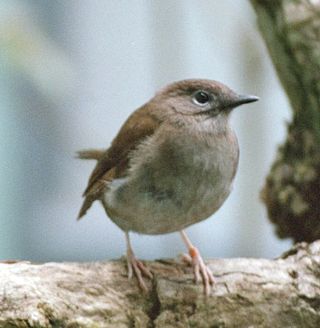
The puaiohi, or small Kauaʻi thrush, is a rare species of songbird in the thrush family, Turdidae, that is endemic to the Hawaiian island of Kauaʻi. It is closely related to the other three endemic Hawaiian thrushes, the kāmaʻo, olomaʻo, and ʻōmaʻo. It was first collected by Henry Palmer in 1891 at Halemanu around the entrance to the Kōkeʻe State Park.

The rufous-throated partridge is a species of bird in the family Phasianidae. It is found in montane forests in India and Southeast Asia. The International Union for Conservation of Nature (IUCN) has assessed it as a least-concern species.

The crestless firebacks are a group of two species of bird in the family Phasianidae. They are found in Brunei, Indonesia, Malaysia, and Singapore. Their natural habitat is subtropical or tropical moist lowland forests. They are threatened by habitat destruction.

The Chinese hwamei or melodious laughingthrush is a passerine bird of eastern Asia in the family Leiothrichidae. The name "hwamei" comes from its Chinese name 畫眉, which means "painted eyebrow", referring to the distinctive marking around the bird's eyes. The species is a popular cagebird because of its attractive song.
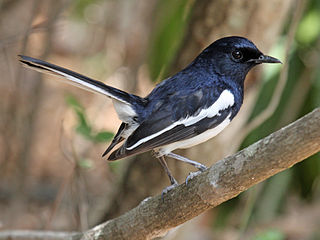
The Madagascar magpie-robin is a species of chat in the Old World flycatcher family, Muscicapidae.

The Black shama is a species of bird in the family Muscicapidae. It is endemic to the island of Cebu, Philippines where it is known locally as "Siloy".

The white-starred robin is a species of bird in the Old World flycatcher and chat family Muscicapidae. It is also sometimes more simply called the starred robin. It is monotypic within the genus Pogonocichla. There are around twelve subspecies. The species is found in East and southern Africa. It is a forest species, occurring in montane forest in the north of its range but closer to sea level further south. This is a brightly coloured robin with a bright yellow breast and belly, a slate coloured head with spots on the eyes and throat and blueish wings.

The Andaman shama is a species of bird in the family Muscicapidae. It is endemic to the Andaman Islands. It was previously considered a subspecies of the white-rumped shama. Its natural habitats are subtropical or tropical dry forests and subtropical or tropical moist lowland forests.

The white-crowned shama is a bird in the Old World flycatcher family. It is endemic to the Southeast Asian island of Borneo.
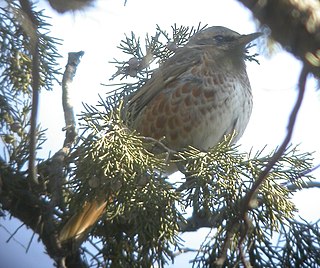
Naumann's thrush is a member of the thrush family Turdidae which breeds eastwards from central Siberia to North Manchuria, Amurland and Sakhalin. It is closely related to the more northerly breeding dusky thrush T. eunomus; the two have often been regarded as conspecific.

